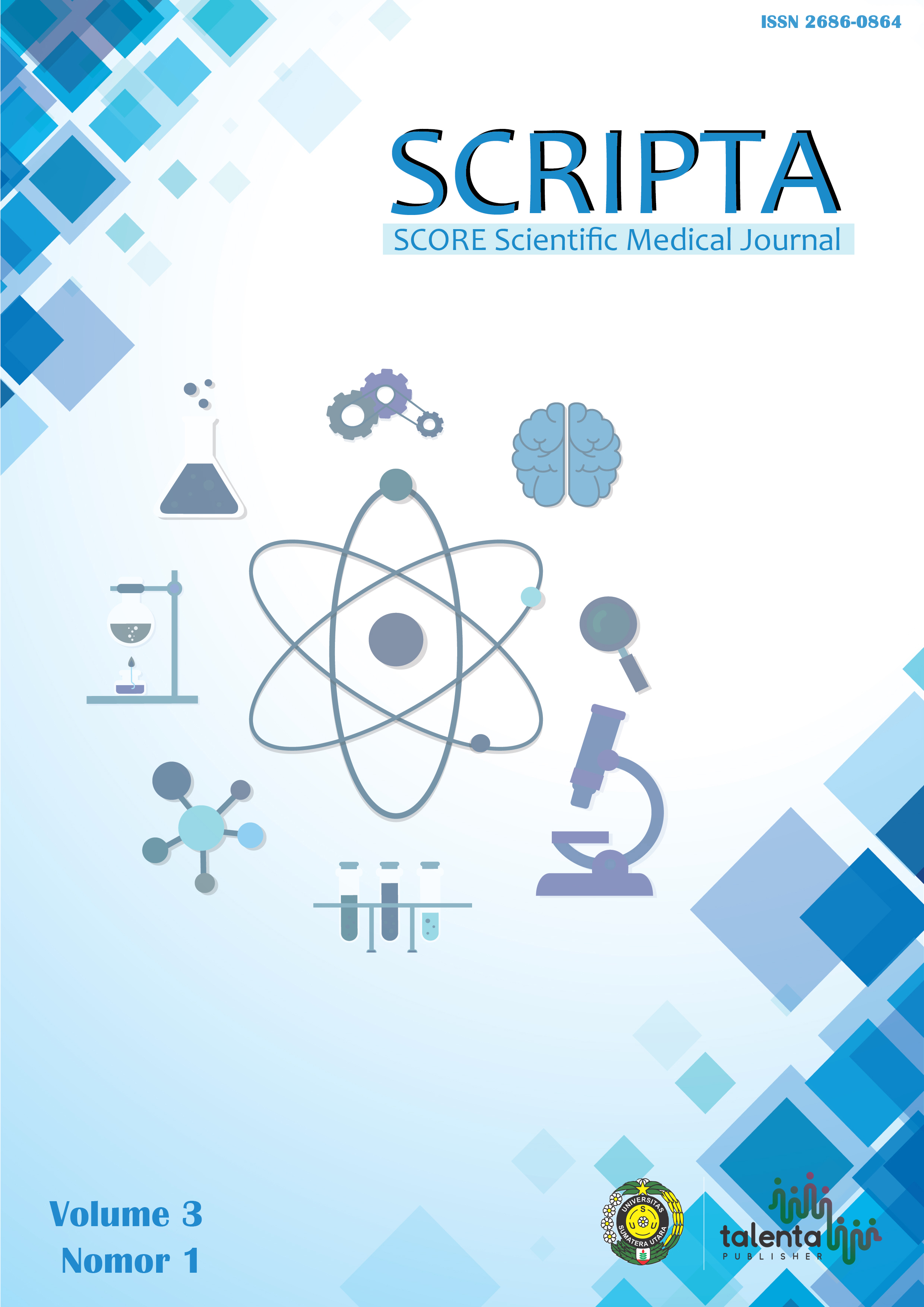Perbandingan antara Penggunaan Tas Ransel dan Tas Sandang dengan Kejadian Nyeri Leher pada Mahasiswa Fakultas Kedokteran Universitas Sumatera Utara Angkatan 2016-2018
DOI:
https://doi.org/10.32734/scripta.v3i1.5564Keywords:
backpacks, messenger packs, neck pain, risk factors for neck pain, faktor risiko nyeri leher, nyeri leher, tas ransel, tas sandangAbstract
Background: Neck pain is a musculoskeletal pain that often occurs in the community. The prevalence of neck pain in the community for 1 year is 40% and higher in women. Neck pain can reduce neck joint movement and functional activity of the neck so that it can disturb one's activities. Neck pain also often occurs in medical students, usually caused by how to use a bag, bag weight, duration of carrying bag, gender and body weight.
Objectives: To determine the prevalence of neck pain and to determine whether there was a comparison between the use of backpacks and messenger bags with the occurrence of neck pain in the students of the Faculty of Medicine University of Sumatera Utara, 2016-2018.
Methods: This study is an analytic study with cross sectional design. The sampling technique used was simple random sampling. The research subjects were 170 people.
Results: Based on comparison of backpack users who experienced neck pain as many as 74 people and messenger bag users who experienced neck pain as many as 65 people with a chi-square analysis (p = 0.112) means it does not have a significant relationship.
Conclusion: the use of backpacks is more likely to cause neck pain than messenger bags, but it is not significant among students of the Faculty of Medicine, University of Sumatera Utara 2016-2018.
Keywords: backpacks, messenger bags, neck pain, risk factors for neck pain
Â
Latar Belakang: Nyeri leher adalah salah satu nyeri muskuloskeletal yang kerap terjadi di masyarakat. Prevalensi nyeri leher yang terjadi di masyarakat selama 1 tahun besarnya 40% dan lebih tinggi pada wanita. Nyeri leher dapat mengurangi gerakan sendi leher dan aktivitas fungsional leher sehingga dapat mengganggu kegiatan seseorang. Nyeri leher juga sering terjadi pada mahasiswa kedokteran, biasanya disebabkan oleh cara penggunaan tas, berat beban tas, durasi membawa tas, jenis kelamin dan berat badan.
Tujuan: Untuk mengetahui apakah terdapat perbandingan antara penggunaan tas ransel dan tas sandang dengan kejadian nyeri leher pada mahasiswa Fakultas Kedokteran Universitas Sumatera Utara angkatan 2016-2018.
Metode: Penelitian ini merupakan penelitian analitik dengan desain cross sectional. Teknik pengambilan sampel yang digunakan adalah teknik simple random sampling. Subjek penelitian adalah 170 orang.
Hasil: Berdasarkan perbandingan pengguna tas ransel yang mengalami nyeri leher sebanyak 74 orang dan pengguna tas sandang yang mengalami nyeri leher sebanyak 65 orang dengan analisa chi-square (p=0,112) yang maksudnya tidak memiliki hubungan yang signifikan.
Kesimpulan: penggunaan tas ransel lebih banyak menimbulkan kejadian nyeri leher dibanding tas sandang namun tidak signifikan pada mahasiswa Fakultas Kedokteran Universitas Sumatera Utara angkatan 2016-2018.
Kata Kunci: faktor risiko nyeri leher, nyeri leher, tas ransel, tas sandang
Downloads
Downloads
Published
How to Cite
Issue
Section
License
Copyright (c) 2021 Rahel Imelda Panggabean, Raden Ajeng Dwi Pujiastuti

This work is licensed under a Creative Commons Attribution-ShareAlike 4.0 International License.
Authors who publish with SCRIPTA SCORE Scientific Medical Journal agree to the following terms:
- Authors retain copyright and grant SCRIPTA SCORE Scientific Medical Journal right of first publication with the work simultaneously licensed under a Creative Commons Attribution-NonCommercial License that allows others to remix, adapt, build upon the work non-commercially with an acknowledgment of the work’s authorship and initial publication in SCRIPTA SCORE Scientific Medical Journal.
- Authors are permitted to copy and redistribute the journal's published version of the work non-commercially (e.g., post it to an institutional repository or publish it in a book), with an acknowledgment of its initial publication in SCRIPTA SCORE Scientific Medical Journal.














